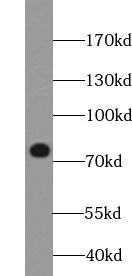Products
CTCFL antibody
| Synonyms: | Transcriptional repressor CTCFL|Brother of the regulator of imprinted sites|CCCTC-binding factor|CTCF paralog|CTCF-like protein|Cancer/testis antigen 27 (CT27)|Zinc finger protein CTCF-T|CTCFL|BORIS antibody | ||
| Catalogue No.: | FNab00932 | Reactivity: | Human, Mouse |
| Host: | Mouse | Tested Application: | ELISA, WB, IF |
| Clonality: | monoclonal | Isotype: | IgG1 |
| Size | Price |
|---|---|
| 100µg | Inquiry |
- SPECIFICATIONS
- FIGURES
- CONDITIONS
- FAQS
- Product Name
- CTCFL antibody
- Catalogue No.
- FNab00932
- Size
- 100μg
- Form
- liquid
- Purification
- Protein A+G purification
- Purity
- ≥95% as determined by SDS-PAGE
- Clonality
- monoclonal
- Isotype
- IgG1
- Clone ID
- 2B10
- Storage
- PBS with 0.02% sodium azide and 50% glycerol pH 7.3, -20℃ for 12 months(Avoid repeated freeze / thaw cycles.)
- Immunogen
- CCCTC-binding factor(zinc finger protein)-like
- Alternative Names
- Transcriptional repressor CTCFL|Brother of the regulator of imprinted sites|CCCTC-binding factor|CTCF paralog|CTCF-like protein|Cancer/testis antigen 27 (CT27)|Zinc finger protein CTCF-T|CTCFL|BORIS antibody
- UniProt ID
- Q8NI51
- Observed MW
- 75 kDa
- Tested Applications
- ELISA, WB, IF
- Recommended dilution
- WB: 1:500-1:2000; IF: 1:10-1:100
 HeLa cells were subjected to SDS PAGE followed by western blot with FNab00932(BORIS antibody) at dilution of 1:1000
HeLa cells were subjected to SDS PAGE followed by western blot with FNab00932(BORIS antibody) at dilution of 1:1000
 Immunofluorescent analysis of MCF-7 cells, using FNab00932(BORIS antibody) at 1:25 dilution andRhodamine-labeled goat anti-mouse IgG (red).
Immunofluorescent analysis of MCF-7 cells, using FNab00932(BORIS antibody) at 1:25 dilution andRhodamine-labeled goat anti-mouse IgG (red).
- Background
- CTCFL, also named BORIS(for brother of the regulator of imprinted sites) is a paralogue of the 11 zinc-finger transcription factor, CTCF. It is predominantly expressed in spermatocytes in the testis, also can be found in tumors and cancer cell lines. It mainly participates in insulator function, nuclear architecture and transcriptional control, which probably acts by recruiting epigenetic chromatin modifiers. It has a key role in gene imprinting in male germline, by participating in the establishment of differential methylation at the IGF2/H19 imprinted control region(ICR). Directly binds the unmethylated H19 ICR and recruits the PRMT7 methyltransferase, leading to methylate histone H4 'Arg-3' to form H4R3sme2.
How many times can antibodies be recycled?
First, usually it's not suggested to recycle antibodies. After use, buffer system of antibodies has changed. The storage condition of recycled antibodies for different customers also varies. Thus, the performance efficiency of recycled antibodies can’t be guaranteed. Besides, FineTest ever conducted the antibody recycling assay. Assay results show recycling times of different antibodies also varies. Usually, higher antibody titer allows more repeated use. Customers can determine based on experimental requirements.
Notes: After incubation, we recycle rest antibodies to centrifuge tube and store at 4℃. High titer antibodies can be stored for a minimum of one week. Reuse about three times.
What are components of FineTest antibody buffer?
Components of FineTest antibody buffer are usually PBS with proclin300 or sodium azide, BSA, 50% glycerol. Common preservative is proclin300 or sodium azide, which is widely applied in the lab and industry.
How about the storage temperature and duration of FineTest antibodies?
Most antibodies are stored at -20℃. Directly-labeled flow cytometry antibodies should be stored at 2 - 8℃. The shelf life is one year. If after sales issues for purchased antibodies appear, return or replacement is available. Usually, antibodies can be still used after the one-year warranty. We can offer technical support services.
Is dilution required for FineTest antibodies? What’s the dilute solution?
Directly-labeled flow cytometry antibodies are ready-to-use without dilution. Other antibodies are usually concentrated. Follow the dilution ratio suggested in the manual. Dilute solution for different experiments also varies. Common antibody dilution buffers are acceptable(e.g. PBST, TBST, antibody blocking buffer).
How to retrieve antibodies for immunohistochemistry?
Common retrieval buffers: Tris-EDTA Buffer(pH 9.0); Citrate Buffer(pH 6.0)
Heat induced antibody retrieval:
Method 1: Water-bath heating: Put the beaker with retrieval buffer and slide in the boiling water bath. Keep the boiling state for 15min. Naturally cool to room temperature;
Method 2: Microwave retrieval: Put the beaker with retrieval buffer and slide in the microwave oven. Heat at high power for 5min, Switch OFF for 3min, Heat at medium power for 5min. Naturally cool to room temperature.
How to choose secondary antibodies?
(1) Secondary antibodies react with primary antibodies. Thus, secondary antibodies should be against host species of primary antibodies. E.g. If the primary antibody is derived from rabbit, the relevant secondary antibody should be against rabbit. E.g. goat anti rabbit or donkey anti rabbit.
(2) Choose secondary antibody conjugates according to the experimental type, e.g. ELISA, WB, IHC etc. Common enzyme conjugated secondary antibodies are labelled by HRP, AP etc. Fluorescin or dye labelled secondary antibodies are applied in immunofluorescence and flow cytometry(e.g. FITC, Cy3).
